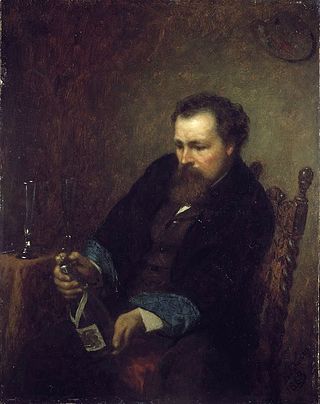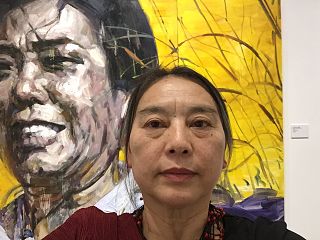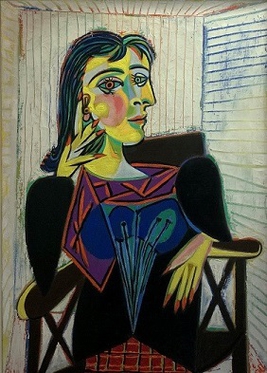
Albert Pinkham Ryder was an American painter best known for his poetic and moody allegorical works and seascapes, as well as his eccentric personality. While his art shared an emphasis on subtle variations of color with tonalist works of the time, it was unique for accentuating form in a way that some art historians regard as modernist.

Jonathan Eastman Johnson was an American painter and co-founder of the Metropolitan Museum of Art, New York City, with his name inscribed at its entrance. He was best known for his genre paintings, paintings of scenes from everyday life, and his portraits both of everyday people and prominent Americans such as Abraham Lincoln, Nathaniel Hawthorne, Ralph Waldo Emerson, and Henry Wadsworth Longfellow. His later works often show the influence of the 17th-century Dutch masters, whom he studied in The Hague in the 1850s; he was known as The American Rembrandt in his day.

Hung Liu (劉虹) was a Chinese-born American contemporary artist. She was predominantly a painter, but also worked with mixed-media and site-specific installation and was also one of the first artists from China to establish a career in the United States.

Helen Galloway McNicoll was a Canadian impressionist painter. She was one of the most notable women artists in Canada in the early twentieth century and achieved considerable success during her decade-long career. McNicoll played an important role in popularizing Impressionism in Canada, at a time when it was still relatively unknown, with her lively representations of rural landscapes, intimate child subjects and modern female figures. She was elected to the Royal Society of British Artists in 1913 and was created an Associate of the Royal Canadian Academy of Arts in 1914.

Emma Lampert Cooper was a painter from Rochester, New York, described as "a painter of exceptional ability". She studied in Rochester, New York; New York City under William Merritt Chase, Paris at the Académie Delécluse and in the Netherlands under Hein Kever. Cooper won awards at several World's Expositions, taught art and was an art director. She met her husband, Colin Campbell Cooper in the Netherlands and the two traveled, painted and exhibited their works together.

The Weeping Woman is a series of oil on canvas paintings by Pablo Picasso, the last of which was created in late 1937. The paintings depict Dora Maar, Picasso's mistress and muse. The Weeping Woman paintings were produced by Picasso in response to the bombing of Guernica in the Spanish Civil War and are closely associated with the iconography in his painting Guernica. Picasso was intrigued with the subject of the weeping woman, and revisited the theme numerous times that year. The last version, created on 26 October 1937, was the most elaborate of the series, and has been housed in the collection of the Tate Modern in London since 1987. Another Weeping Woman painting created on 18 October 1937 is housed at the National Gallery of Victoria and was involved in a high-profile political art theft.

Elizabeth Nourse was a realist-style genre, portrait, and landscape painter born in Mt. Healthy, Ohio, in the Cincinnati area. She also worked in decorative painting and sculpture. Described by her contemporaries as "the first woman painter of America" and "the dean of American woman painters in France and one of the most eminent contemporary artists of her sex," Nourse was the first American woman to be voted into the Société Nationale des Beaux-Arts. She also had the honor of having one of her paintings purchased by the French government and included in the Luxembourg Museum's permanent collection. Nourse's style was described by Los Angeles critic Henry J. Seldis as a "forerunner of social realist painting." Some of Nourse's works are displayed at the Cincinnati Art Museum.

John Reinhard Weguelin was an English painter and illustrator, active from 1877 to after 1910. He specialized in figurative paintings with lush backgrounds, typically landscapes or garden scenes. Weguelin emulated the neo-classical style of Edward Poynter and Lawrence Alma-Tadema, painting subjects inspired by classical antiquity and mythology. He depicted scenes of everyday life in ancient Greece and Rome, as well as mythological subjects, with an emphasis on pastoral scenes. Weguelin also drew on folklore for inspiration, and painted numerous images of nymphs and mermaids.

The Split of Life is a series of over 80 mural size oil paintings by Nabil Kanso. The paintings span a period from 1974 to 1994, and deal with contemporary and historical issues of war and violence.

Honoré Desmond Sharrer was an American artist. She first received public acclaim in 1950 for her painting Tribute to the American Working People, a five-image polyptych conceived in the form of a Renaissance altarpiece, except that its central figure is a factory worker and not a saint. Flanking this central figure are smaller scenes of ordinary people—at a picnic, in a parlor, on a farm and in the schoolroom. Meticulously painted in oil on composition board in a style and color palette reminiscent of the Flemish Masters, the finished work is more than six feet long and three feet high and took her five years to complete. It was the subject of a 2007 retrospective at the Smithsonian Institution and is part of the permanent collection of the Smithsonian American Art Museum.

Stevenson Memorial is a 1903 oil painting by the American artist Abbott Handerson Thayer, intended to commemorate the writer Robert Louis Stevenson. Though Thayer initiated several paintings with the intent of honoring Stevenson, Stevenson Memorial is the only version to survive the artist's revisions.

Penitent Magdalene is a 16th-century oil on canvas painting by Italian Baroque painter Caravaggio. The painting portrays a repentant Mary Magdalene, bowed over in penitent sorrow as she leaves behind her dissolute life, its trappings abandoned beside her. At the time of its completion, ca. 1594–1595, the painting was unconventional for its contemporary realism and departure from traditional Magdalene iconography. It has invited both criticism and praise, with speculation even into the 21st century as to Caravaggio's intentions. The work hangs in the Doria Pamphilj Gallery in Rome.

Matthew Pratt was an American "Colonial Era" artist famous for his portraits of American men and women. He was born in Philadelphia, Province of Pennsylvania to goldsmith Henry Pratt, (1708–1748) and Rebecca Claypoole, (1711–1762), he was the second of eight children born to the Pratts.

The Founding Ceremony of the Nation is a 1953 oil painting by Chinese artist Dong Xiwen. It depicts Chairman Mao Zedong and other Communist Party officials proclaiming the People's Republic of China at Tiananmen Square on October 1, 1949. A prominent example of socialist realism, it is one of the most celebrated works of official Chinese art. The painting was repeatedly revised, and a replica painting made to accommodate further changes, as the leaders it depicted fell from power and later were rehabilitated.

The Graham Children is an oil painting completed by William Hogarth in 1742. It is a group portrait depicting the four children of Daniel Graham, apothecary to King George II. The youngest child had died by the time the painting was completed.

Au Lapin Agile is a 1905 oil on canvas painting by Pablo Picasso. It depicts the interior of the Lapin Agile, a famous cabaret club in the Montmartre area of Paris. The composition was produced during Picasso's Rose Period and includes a self-portrait of the artist who frequented the club in his youth. The painting is listed as one of the most expensive paintings after achieving a price of $40.7 million at Sotheby's auction on 27 November 1989. It is housed in the collection of the Metropolitan Museum of Art in New York City.

Georgia O'Keeffe made a number of Red Canna paintings of the canna lily plant, first in watercolor, such as a red canna flower bouquet painted in 1915, but primarily abstract paintings of close-up images in oil. O'Keeffe said that she made the paintings to reflect the way she herself saw flowers, although others have called her depictions erotic, and compared them to female genitalia. O'Keeffe said they had misconstrued her intentions for doing her flower paintings: "Well – I made you take time to look at what I saw and when you took time to really notice my flower you hung all your own associations with flowers on my flower and you write about my flower as if I think and see what you think and see of the flower – and I don't."
Bertha Eversfield Perrie was an American painter. She has been described as "about the only famous Washington artist who was actually born in D.C."

Portrait of Dora Maar is a 1937 oil on canvas painting by Pablo Picasso. It depicts Dora Maar,, the painter's lover, seated on a chair. It is part of the collection of the Musée Picasso, in Paris, where it is considered to be one of Picasso's masterpieces.

On a French River is an impressionist oil painting on canvas painted by the artist Emma Lampert Cooper during the late 1800s. It is a landscape painting that depicts a river scene in Parthenay, France. It is part of the permanent collection at the Memorial Art Gallery (MAG) in Rochester, New York.Emma Lampert Cooper's husband, Colin Campbell Cooper, also produced similar paintings in the same location when they traveled together. Specifically, the paintings titled Port St. Jacques, Parthenay, France, and A View of a European Village. Both of these paintings have been auctioned in the past and are privately owned.



















